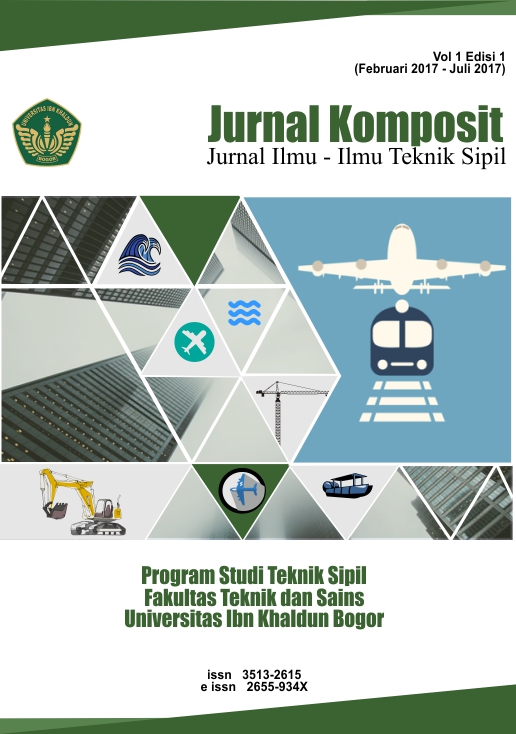TANTANGAN PEMBANGUNAN JALAN PADA LINGKUNGAN PANTAI
DOI:
https://doi.org/10.32832/komposit.v1i1.4755Abstract
ABSTRAKSempadan pantai merupakan kawasan yang secara undang-undang merupakan kawasan lindung yang memiliki fungsi utama untuk menjaga kelestarian lingkungan hidup. Pembangunan di kawasan pantai tidak dapat dihindari dan seringkali melanggar batas-batas sempadan. Jalan sebagai salah satu infrastruktur penting terkadang dibangun di kawasan pantai dan berada dalam batas sempadan pantai. Hal itu tidak melanggar peraturan yang sudah ada, karena fungsi jalan di kawasan pantai adalah sebagai jalan masuk dan jalan evakuasi bila terjadi bencana. Akan tetapi dalam perencanaannya, kondisi lingkungan pantai seringkali diabaikan, akibatnya jalan menjadi capat rusak. Oleh karena itu dalam perencanaan jalan pesisir perlu diperhatikan aspek keilmuan teknik pantai, seperti pengetahuan mengenai gelombang, pasang surut, transport sedimen, agar jalan yang dibangun mampu memenuhi syarat kelestarian fisik dan fungsi jalan.
Kata kunci: sempadan pantai, pantai, pesisir, jalan pesisir
ABSTRACTCoastal borders are areas that are legally protected areas that have the main function of preserving the environment. Development in coastal areas is unavoidable and often breaches boundaries. Roads as one of the important infrastructures are sometimes built in coastal areas and are within the coastal boundary. This does not violate existing regulations, because the function of roads in the coastal area is as an entrance and evacuation route in the event of a disaster. However, in its planning, the condition of the coastal environment is often neglected, as a result of which the road can be quickly damaged. Therefore, in the planning of coastal roads, it is necessary to pay attention to the scientific aspects of coastal engineering, such as knowledge of waves, tides, sediment transport, so that the roads built can meet the physical preservation and function requirements of the road.
Keywords: coastal boundaries, beaches, coasts, coastal roads
References
AASHTO. (1999) "Guidelines for Highways Along Coastal Zones and Lakeshores.” Volume XI. Prepared by the Task Force on Hydrology and Hydraulics. American Association of State Highway and Transportation Officials. Washington, D.C.
Bruun, P. (1962). Sea-Level Rise As A Cause Of Shore Erosion, Journal of The Waterways and Harbors Division, American Society of Civil Engineers, vol. 88, no ww1, proceedings paper 3065, p 117-130.
Gornitz, V. (1990). Vulnerability of the East Coast, USA to future sea level rise. Journal of Coastal Research, Special Issue No. 9, pp. 201–237.
Hammar-Klose, E.S., Thieler, E.R., (2001). Coastal Vulnerability to Sea-Level Rise: A Preliminary Database for the U.S. Atlantic, Pacific and Gulf of Mexico Coasts, U.S. Geological Survey Digital Data Series – 68
Intergovernmental Panel on Climate Change (IPCC). (2007). Climate Change 2007: Impacts, Adaption and Vulnerability Contribution of Working Group II to the Third Assessment Report of the Intergovernmental Panel on Climate Change. Parry, M. L. et al. (editors.). Cambridge University Press.
Klein, R. J. T., Nicholls, R. J., Ragoonaden, S., Capobianco, M., Aston, J., Buckley, E.N. (2001). Technological Options for Adaptation to Climate Change in Coastal Zones, Journal of Coastal Research, Vol. 17, No. 3, pp. 531-543
Ministry of Environment, (2010). Indonesia Second National Communication: Under UNFCCC Framework. Nicholls, R. J., 1995. Coastal Megacities and Climate Change, Geo Journal, Vol. 373, pp. 369-379.
Nicholls, R.J., Wong P.P., Burkett, V.R., Codignotto, J.O., Hay, J.E., McLean, R.F., Ragoonaden, S., Woodroffe, C.D. (2007). Coastal systems and low-lying areas. Climate Change 2007: Impacts, Adaptation and Vulnerability. Contribution of Working Group II to the Fourth Assessment Report of the Intergovernmental Panel on Climate Change. M.L. Parry, O.F. Canziani, J.P. Palutikof, P.J.van der Linden and C.E. Hanson, eds., Cambrige University Press, Cambridge, UK, 315-356.
í–zyurt, G., Ergin. A., (2010). Improving Coastal Vulnerability Assessments to Sea-Level Rise: A New Indicator-Based Methodology for Decision Makers. Journal of Coastal Research: Volume 26, Issue 2: pp. 265 – 273.
Post, J.C., Lundin, C.G., (1996). Guidelines for integrated coastal zone management, World Bank
Richard S. J. Tol, Richard J. T. Klein and Robert J. Nicholls (2008). Towards Successful Adaptation to Sea- Level Rise along Europe's Coasts. Journal of Coastal Research: Volume 24, Issue 2: pp. 432 – 442.
Downloads
Published
How to Cite
Issue
Section
License
Authors who publish with this journal agree to the following terms (Penulis yang mengajukan publikasi artikel telah menyetujui hal berikut):
- Through this publication, the author agree to submit the copyright of article writing to Jurnal Komposit: Jurnal Ilmu-ilmu Teknik Sipil. This copyright submission takes the form of, but is not limited to: reproduction of the article and parts therein, including photographic reproductions; distribution of articles through printed and electronic documents; and translation of articles(Bahwa melalui publikasi ini, hak cipta penulisan artikel diserahkan kepada Jurnal Komposit: Jurnal Ilmu-ilmu Teknik Sipil. Penyerahan hak cipta ini berupa, namun tidak terbatas pada: perbanyakan artikel dan bagian di dalamnya, termasuk reproduksi fotografi; penyebarluasan artikel melalui dokumen cetak dan elektronik; serta penterjemahan artikel).
- The authors agree to the terms of the Copyright Notice, according to Creative Commons Attribution-NonCommercial-ShareAlike 4.0 International License., which will apply to this article if and when it is published by Jurnal Komposit: Jurnal Ilmu-ilmu Teknik Sipil. (Para penulis setuju dengan ketentuan Pemberitahuan Hak Cipta, sesuai dengan Lisensi Internasional Creative Commons Attribution-NonCommercial-ShareAlike 4.0., yang akan berlaku untuk artikel ini jika dan ketika diterbitkan oleh Jurnal Komposit: Jurnal Ilmu-ilmu Teknik Sipil).

This work is licensed under a Creative Commons Attribution-NonCommercial-ShareAlike 4.0 International License.



.png)










